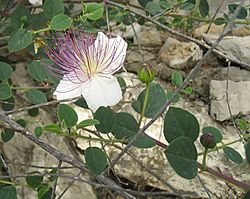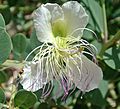Caper facts for kids
Quick facts for kids Caper |
|
|---|---|
 |
|
| Scientific classification | |
| Kingdom: | |
| (unranked): | |
| (unranked): | |
| (unranked): | |
| Order: | |
| Family: | |
| Genus: |
Capparis
|
| Species: |
C. spinosa
|
| Binomial name | |
| Capparis spinosa Linnaeus, 1753
|
|
The caper bush, also known as Capparis spinosa or Flinders rose, is a special plant. It grows year after year and has round, thick leaves. Its flowers are large and can be white or light pink.
This plant is famous for its edible flower buds, which are called capers. People often use capers to add flavor to food. The plant also grows fruits called caper berries. Both capers and caper berries are usually eaten after being pickled.
Other types of Capparis plants are also picked for their buds or fruits. Different parts of caper plants are even used to make medicines and beauty products.
You can find the caper bush growing wild in many places. These include the Mediterranean region, East Africa, Madagascar, and parts of Central Asia and Australia. It grows in almost all countries around the Mediterranean Sea. We are not sure if it first grew there or if it came from warmer, tropical areas.
Culinary Uses of Capers
The caper is a flower bud that has been salted or pickled. People often use it to add flavor or as a decoration on food. Capers are a very common ingredient in Mediterranean cuisine, especially in Italian and Maltese dishes. The ripe fruit of the caper plant is called a caper berry. These are also prepared in a similar way.
When caper buds are ready to be picked, they are a dark olive green color. They are about the size of a fresh kernel of corn. After picking, they are pickled in salt or a mix of salt and vinegar. This process helps them develop a strong flavor.
Capers are a key ingredient in Italian cooking, especially in Sicilian and southern Italian food. You will often find them in salads, meat dishes, and pasta sauces. For example, they are used in dishes like chicken piccata and spaghetti alla puttanesca.
Capers are also a well-known ingredient in tartar sauce. They are often served with cold smoked or cured salmon. Sometimes, capers and caper berries are used instead of olives to decorate a martini drink.
Caper Sizes and Leaves
Capers are sorted and sold by their size. Smaller capers are usually more desired. Here are the sizes:
- Non-pareil: Up to 7 millimeters (very small)
- Surfines: 7–8 millimeters
- Capucines: 8–9 millimeters
- Capotes: 9–11 millimeters
- Fines: 11–13 millimeters
- Grusas: 14+ millimeters (largest)
If a caper bud is not picked, it will bloom into a flower and then produce a caper berry. These berries can also be pickled and served as a mezze (small dish) in Greece.
Caper leaves are harder to find outside of Greece or Cyprus. They are used in salads and fish dishes. Like the buds, they can be pickled or boiled and stored in jars with salty water. Dried caper leaves can even be used to help make certain types of cheese.
Images for kids
-
Კაპარი Capparis spinosa Kapernstrauch.JPG
Leaves and flower buds
-
Caper bushes on the Western Wall in Jerusalem
-
Caper bush growing on the Western Wall, Jerusalem
See also
 In Spanish: Capparis spinosa para niños
In Spanish: Capparis spinosa para niños




















